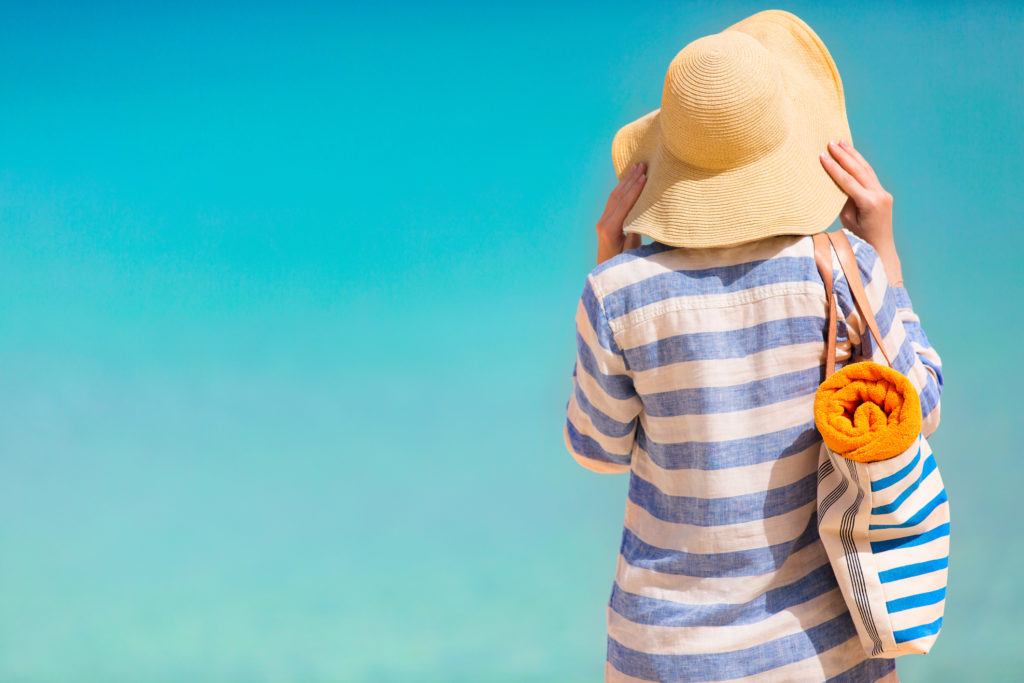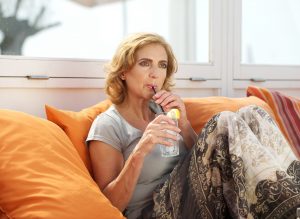Summer’s high temperatures and humidity can pose risks to cancer survivors. Living with neuroendocrine tumors may make you more vulnerable to the sun and heat. Learn how to prevent heat-related illness in neuroendocrine cancer.
Why do those with neuroendocrine cancer have to be more careful?
- Certain cancer treatments, like chemotherapy, can increase sun sensitivity.
- Hair loss may lead to scalp sunburn.
- Skin exposed to radiation treatment may burn more easily.
- Surgical scars must be protected from the sun to avoid sun damage.
- Summer heat can intensify cancer-related fatigue.
If you live with neuroendocrine cancer, protect yourself from the summer heat
- Stay Hydrated. Drink more fluids, regardless of how active you are, especially if you are experiencing increased bowel movements. Don’t wait until you’re thirsty to drink.

Stay hydrated by drinking water often. - Replace Salt and Minerals: Heavy sweating removes salt and minerals from the body that need to be replaced. Hydration drinks can replace the salt and minerals you lose by sweating. Talk to your doctor about what drinks may be best for you.
- Wear Sunscreen: Sunburn affects your body’s ability to cool down and can make you dehydrated. Generously apply a broad-spectrum (UVA/UVB), water-resistant sunscreen of SPF 30 or higher 30 minutes before going out. Reapply about every two hours—sooner if you swim or sweat.
- Wear Appropriate Clothing: Choose lightweight, light-colored, loose-fitting clothing. Always wear a wide-brimmed hat and sunglasses. Use an umbrella if needed for shade.
- Stay Cool Indoors: Stay in an air-conditioned place as much as possible. If your home does not have air conditioning, go to the shopping mall or public library—even a few hours spent in air conditioning can help your body stay cooler when you go back into the heat. Electric fans may provide comfort, but when the temperature is in the high 90s, they will not prevent heat-related illness. Taking a cool shower or bath or moving to an air-conditioned place can be a much better way to cool off.
- Schedule Outdoor Activities Carefully: Try to limit your outdoor activity to when it’s coolest, like morning and evening hours. Rest often in shady areas so that your body has a chance to recover.
- Pace Yourself: Cut down on exercise during the heat. If exertion in the heat makes your heart pound and leaves you gasping for breath, STOP all activity. Get into a cool area or the shade, and rest, especially if you become lightheaded, confused, weak, or faint.
- Eat light: Eat smaller meals, more often. Try not to use your oven or stovetop if you don’t have air conditioning. Avoid hot and heavy meals.
Be on the lookout for signs of heat-related illness
[Click or tap below to see warning signs and treatment tips for heat-related illness.]
WHAT TO LOOK FOR
- High body temperature (103°F or higher)
- Hot, red, dry, or damp skin
- Fast, strong pulse
- Headache
- Dizziness
- Nausea
- Confusion
- Losing consciousness (passing out)
WHAT TO DO
- Call 911 right away-heat stroke is a medical emergency
- Move the person to a cooler place
- Help lower the person’s temperature with cool cloths or a cool bath
- Do not give the person anything to drink
WHAT TO LOOK FOR
- Heavy sweating
- Cold, pale, and clammy skin
- Fast, weak pulse
- Nausea or vomiting
- Muscle cramps
- Tiredness or weakness
- Dizziness
- Headache
- Fainting (passing out)
WHAT TO DO
- Move to a cool place
- Loosen your clothes
- Put cool, wet cloths on your body or take a cool bath
- Sip water
- Get medical help right away if
- You are throwing up
- Your symptoms get worse
- Your symptoms last longer than 1 hour
WHAT TO LOOK FOR
- Heavy sweating during intense exercise
- Muscle pain or spasms
WHAT TO DO
- Stop physical activity and move to a cool place
- Drink water or a sports drink
- Wait for cramps to go away before you do any more physical activity
- Get medical help right away if:
- Cramps last longer than 1 hour
- You’re on a low-sodium diet
- You have heart problems
WHAT TO LOOK FOR
- Red clusters of small blisters that look like pimples on the skin (usually on the neck, chest, groin, or in elbow creases)
WHAT TO DO
- Stay in a cool, dry place
- Keep the rash dry
- Use aloe vera gel or other topical treatments to soothe the rash
Taking a few extra precautions can help you safely navigate summer’s high temperatures, without risking any health setbacks or emergencies. Stay safe. Stay strong. Don’t let the heat get in the way of healthy living this summer.
Sources: National Center for Environmental Health (NCEH)/Agency for Toxic Substances and Disease Registry (ATSDR), Coordinating Center for Environmental Health and Injury Prevention (CCEHIP); Centers for Disease Control (CDC); National Comprehensive Cancer Network® (NCCN) Patient and Caregiver Resources.


